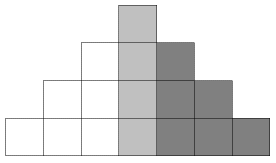
Double StaircaseTask 61 ... Years 4 - 10SummaryStudents build staircases of cubes up to a platform and then match the steps down the other side. The challenge is to predict the number of blocks needed to build a double staircase of a given height.This task is a development of Task 51, Staircase. Also Staircase is the stimulus investigation for the DIY workshop video Aiming High? Dig Deeper which explores a pedagogy of achieving high aims in mathematics by digging deeper into fertile learning ground such as this task, rather than too quickly moving on to something new. The video highlights teaching craft - for example visual and kinaesthetic learning and journal writing in maths - and uncovers mathematics content from Year 1 to Year 12. Its introductory video Staircase Maths (in less than one minute) will give you an idea of the content (and teaching craft). |
Materials
Content
|

IcebergA task is the tip of a learning iceberg. There is always more to a task than is recorded on the card. |
The action of building the double staircase is well within the grasp of quite young students. It is also possible for them to work out the total of blocks for a 10-step stair in either pattern on the card, since each can be modelled with square paper or tiles or more blocks, or drawn on graph paper. A calculator might also be a useful tool. If the focus of the problem was the answer, then this could be all we required. However, if the focus is learning to work like a mathematician, then we need to ask the mathematician's question: Can I check it another way? This may encourage students to look for connections both visually and numerically. For example, the Question 1 diagram could be thought of as two sets of steps 1 to 3 plus a column of four up the middle. 
More importantly, this process describes how to work out the total of cubes for any height double staircase of the Question 1 variety. Question 2 might encourage a different way of 'seeing'. They might notice that the towers on the right side of the middle could be used on top of the 'other tower' on the left side to make two towers of 6 to the left of the central tower. That makes it easy to count the 18 in the diagram of Question 2. A 10 step version of this staircase would have towers of 2, 4, 6, ... 18 up each side and a central column of 20. The towers on the right could all be added to a partner on the left to make 9 columns of 20, plus the central one. Again, easier to calculate the 10 lots of 20 and get 200. Of course, you could also 'swap' approaches between Questions 1 and 2, and there are, no doubt, other ways to look at the staircase patterns. Additional questions which help explore the iceberg for each diagram are:
|
Whole Class InvestigationTasks are an invitation for two students to work like a mathematician. Tasks can also be modified to become whole class investigations which model how a mathematician works. |
|
Is it in Maths With Attitude?Maths With Attitude is a set of hands-on learning kits available from Years 3-10 which structure the use of tasks and whole class investigations into a week by week planner. |
The Double Staircase task is an integral part of:
The Staircases lesson is an integral part of:
|